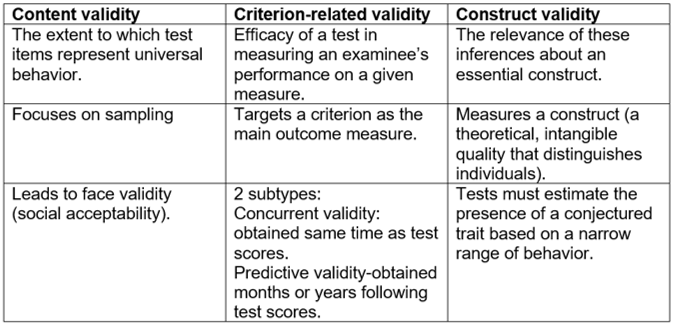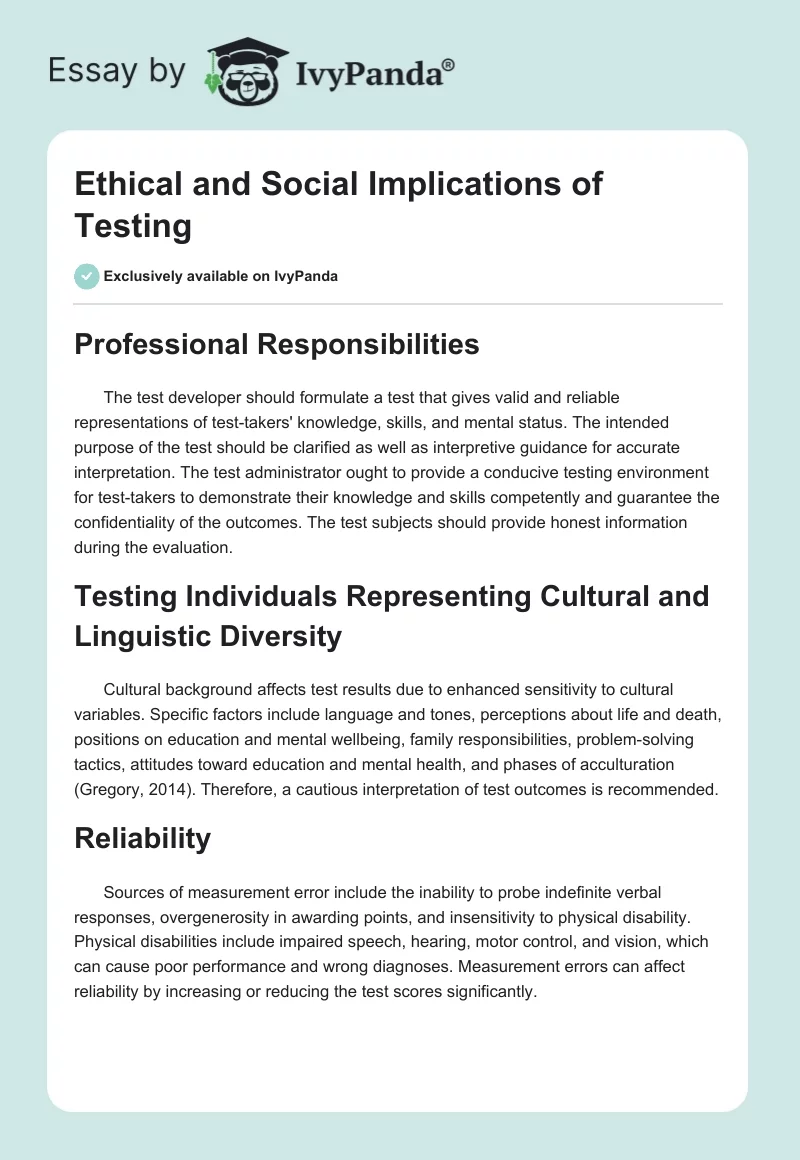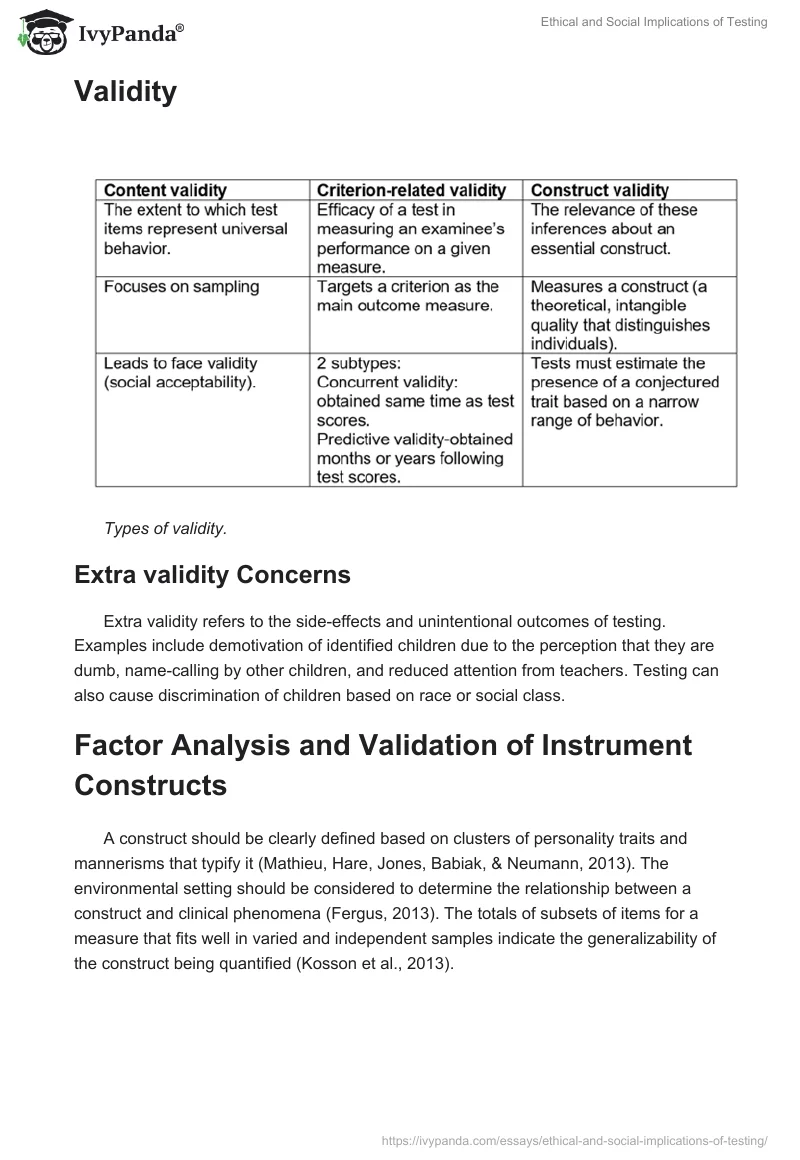Professional Responsibilities
The test developer should formulate a test that gives valid and reliable representations of test-takers’ knowledge, skills, and mental status. The intended purpose of the test should be clarified as well as interpretive guidance for accurate interpretation. The test administrator ought to provide a conducive testing environment for test-takers to demonstrate their knowledge and skills competently and guarantee the confidentiality of the outcomes. The test subjects should provide honest information during the evaluation.
Testing Individuals Representing Cultural and Linguistic Diversity
Cultural background affects test results due to enhanced sensitivity to cultural variables. Specific factors include language and tones, perceptions about life and death, positions on education and mental wellbeing, family responsibilities, problem-solving tactics, attitudes toward education and mental health, and phases of acculturation (Gregory, 2014). Therefore, a cautious interpretation of test outcomes is recommended.
Reliability
Sources of measurement error include the inability to probe indefinite verbal responses, overgenerosity in awarding points, and insensitivity to physical disability. Physical disabilities include impaired speech, hearing, motor control, and vision, which can cause poor performance and wrong diagnoses. Measurement errors can affect reliability by increasing or reducing the test scores significantly.
Validity

Extra validity Concerns
Extra validity refers to the side-effects and unintentional outcomes of testing. Examples include demotivation of identified children due to the perception that they are dumb, name-calling by other children, and reduced attention from teachers. Testing can also cause discrimination of children based on race or social class.
Factor Analysis and Validation of Instrument Constructs
A construct should be clearly defined based on clusters of personality traits and mannerisms that typify it (Mathieu, Hare, Jones, Babiak, & Neumann, 2013). The environmental setting should be considered to determine the relationship between a construct and clinical phenomena (Fergus, 2013). The totals of subsets of items for a measure that fits well in varied and independent samples indicate the generalizability of the construct being quantified (Kosson et al., 2013).
Clinical Versus Statistical Prediction
Clinical prediction involves the direct use of data from psychometric tests, observations, and interviews to foretell the occurrence of a given condition (Grove & Lloyd, 2006). Conversely, statistical prediction codes the prediction data and uses mathematical models to foretell a mental health decision. Statistical predictions of mental health decisions are more accurate than clinical predictions (Ægisdóttir et al., 2006; Grove & Lloyd, 2006). Besides, clinical prediction models are often simpler and more straightforward than statistical prediction.
Application One: An Ethical and Professional Quandary
Using a translator when administering an individual test such as the WISC-IV is an inappropriate practice. Intended meaning could be lost in the translation process, thus affecting the accuracy, reliability, and validity of the test. The practice also breaches the ethical principles of privacy and confidentiality (American Psychological Association, 2010). By involving a translator in the testing process, an unauthorized translator is included in the testing procedure thus violating standard 9.07. The best way to approach the challenge would be to enlist help from an expert who is proficient in English and Spanish to administer the test.
Application Two: Evidence-Based Medicine
Youngstrom (2013) recommends blending the evidence-based medicine (EBM) viewpoint with psychological evaluations to produce a robust hybrid approach that is more client-focused. This process involves a series of 12 steps:
- Identifying prevalent diagnoses in a health setting;
- Obtaining knowledge of base rates;
- Assessing pertinent risks and regulating factors;
- Transforming broad instruments into shortened probability estimations;
- Augmenting restricted and incremental assessments to elucidate diagnoses;
- Decoding cross-informant data arrays;
- Confirming diagnoses by supplementing necessary intensive assessment techniques;
- Finalizing evaluation to establish treatment goals and plans;
- Quantifying progressions;
- Keeping a record of progress and upshots;
- Keeping an eye on continuance and relapse;
- Finding and incorporating patient partialities.
Application Three: Selecting Valid Instruments
JM is a nursing student who wishes to become a Psychiatric nurse and is aware that she must pass her current bachelor’s program, pursue a master’s and Doctor of Nursing Practice degrees before realizing her dream. She needs money for tuition fee and must have a stable source of income. She is anxious about the situation, which is affecting her current academic performance. The most appropriate instrument to measure intolerance for uncertainty is the Intolerance of Uncertainty Index–Part A (IUI–A). This test assesses difficulty tolerating or accepting uncertainties (Fergus, 2013).
Mental Development and Learning Abilities
Johnny is a 6-year-old boy who goes to school at Achievers’ Academy. He is in Grade 1. Johnny likes singing, dancing, and making toys out of used plastic cans. He also enjoys going to school because he gets to learn many new things and interact with other students. He listens keenly to all his teachers as they explain concepts in various subjects. His father works as a pilot in a prestigious airline. Johnny would also like to become a pilot when he grows up.
His father tells him that he has to work hard in school and score very good grades to become a competent pilot. Therefore, Johnny’s current fear is to perform poorly in class. However, his academic grades at the moment are not very good, which has made Johnny very unhappy. Johnny’s Mathematics teacher has observed that Johnny is no longer happy and active during Mathematics lessons. She asks Johnny why he seems sad lately.
He replies that he would like to do well in class, but he does not understand what normally happens during tests. The Mathematics teacher consulted Johnny’s classroom teacher and agreed that they should help Johnny by finding out what could be the cause of his poor academic performance. The two teachers decide to administer mental health assessment tests.
The assessment will be done by Johnny’s classroom teacher in the classroom setting.
The chosen test is an intelligence quotient (IQ test), which will be used to measure Johnny’s learning abilities. Two versions will be used: the Stanford-Binet test and the Wechsler Individual Achievement Test (Giofre, Toffalini, Altoè, & Cornoldi, 2017).
Testing will take approximately one hour.
Johnny’s classroom teacher will be present in the room when Johnny takes the test. His mother will not be in school. However, she will be informed about Johnny’s concerns and the decision to administer the test. Her permission regarding the matter will be sought by the teacher before giving the test.
The test results will be used to provide a customized evaluation of Johnny’s abilities. Based on the findings of the test, Johnny’s teachers can use the test outcomes to determine the most suitable learning approach to use with Johnny to maximize his potential. If the test reveals any learning disabilities, the teachers will be able to take the appropriate steps to support Johnny’s learning. IQ tests yield optimal outcomes if administered early because of the timely administration of the assessments promotes prompt interventions (WebMD, 2019).
The test results will be made available to Johnny’s doctor, teachers, and parents because they are best placed to provide Johnny with the required help. His parents will use the test outcomes to create a conducive home environment for him to maximize his potential (Giofre et al., 2017). His doctor will determine whether he has any other mental or developmental problems.
The outcome of the assessment will show that Johnny has a low IQ of about 70. The normal range of IQ should be between 85 and 100 (Giofre et al., 2017). This information will be used to guide his teachers and parents to make special accommodations for his learning. The outcomes of this test will affect Johnny’s life academically because he will need extra help from his teachers using a specialized learning approach to catch up with his fellow students. However, he will continue living a normal life outside of class.
References
Ægisdóttir, S., White, M. J., Spengler, P. M., Maugherman, A. S., Anderson, L. A., Cook, R. S., … Rush, J. D. (2006). The meta-analysis of clinical judgment project: Fifty-six years of accumulated research on clinical versus statistical prediction. The Counseling Psychologist, 34(3), 341-382. Web.
American Psychological Association. (2010). Standard 9: Assessment. Web.
Fergus, T. A. (2013). A comparison of three self-report measures of intolerance of uncertainty: An examination of structure and incremental explanatory power in a community sample. Psychological Assessment, 25(4), 1322-1331. Web.
Giofre, D., Toffalini, E., Altoè, G., & Cornoldi, C. (2017). Intelligence measures as diagnostic tools for children with specific learning disabilities. Intelligence, 61, 140-145.
Gregory, R. J. (2014). Psychological testing: History, principles, and applications (7th ed.). Boston, MA: Pearson.
Grove, W. M., & Lloyd, M. (2006). Meehl’s contribution to clinical versus statistical prediction. Journal of Abnormal Psychology, 115(2), 192-194. Web.
Kosson, D. S., Neumann, C. S., Forth, A. E., Salekin, R. T., Hare, R. D., Krischer, M. K., & Svecke, K. (2013). Factor structure of the Hare Psychopathy Checklist: Youth Version (PCL: YV) in adolescent females. Psychological Assessment, 25(1), 71-83. Web.
Mathieu, C., Hare, R. D., Jones, D. N., Babiak, P., & Neumann, C. S. (2013). Factor structure of the B-Scan 360: A measure of corporate psychopathy. Psychological Assessment, 25(1), 288-293. Web.
Youngstrom, E. A. (2013). Future directions in psychological assessment: Combining evidence-based medicine innovations with psychology’s historical strengths to enhance utility. Journal of Clinical Child & Adolescent Psychology. 42(1), 139-159. Web.
WebMD. (2019). What are mental health assessments? Web.


